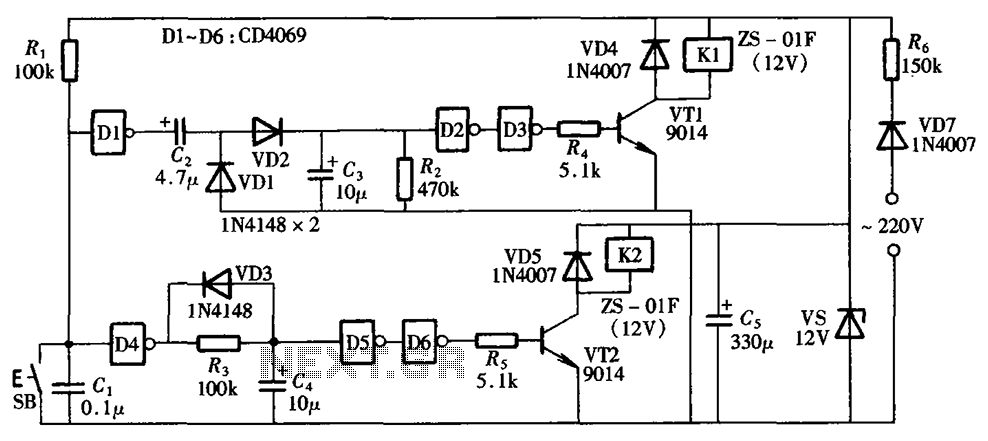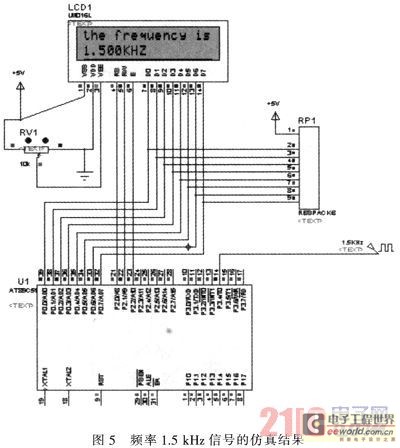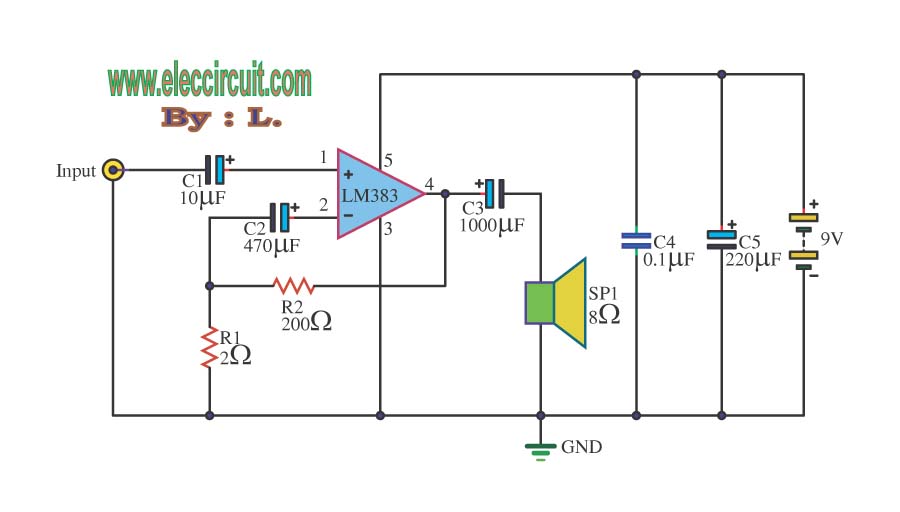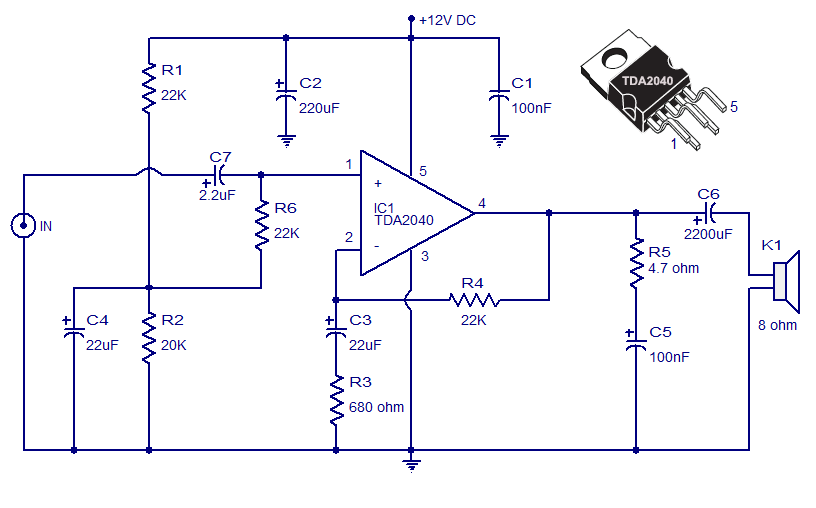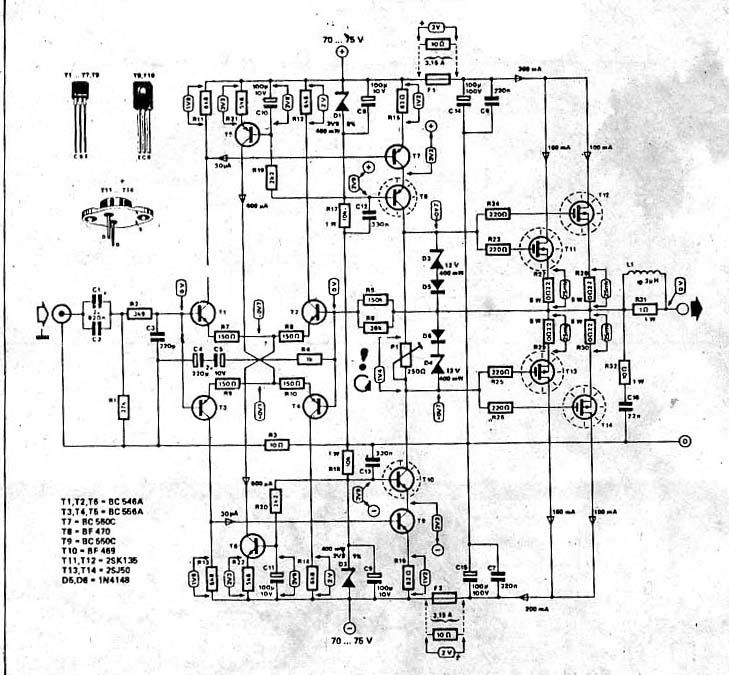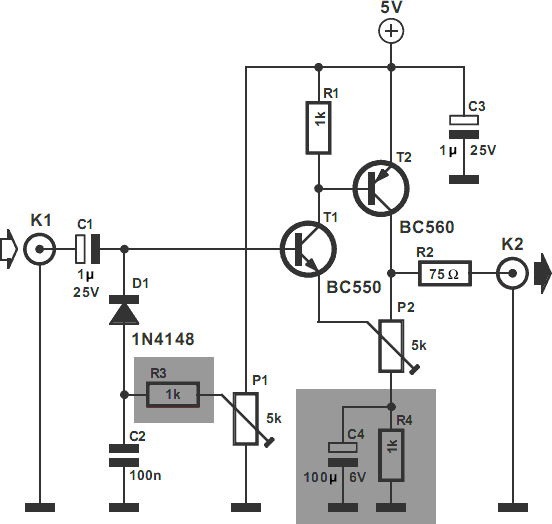
The Design of Car Audio Power Amplifier
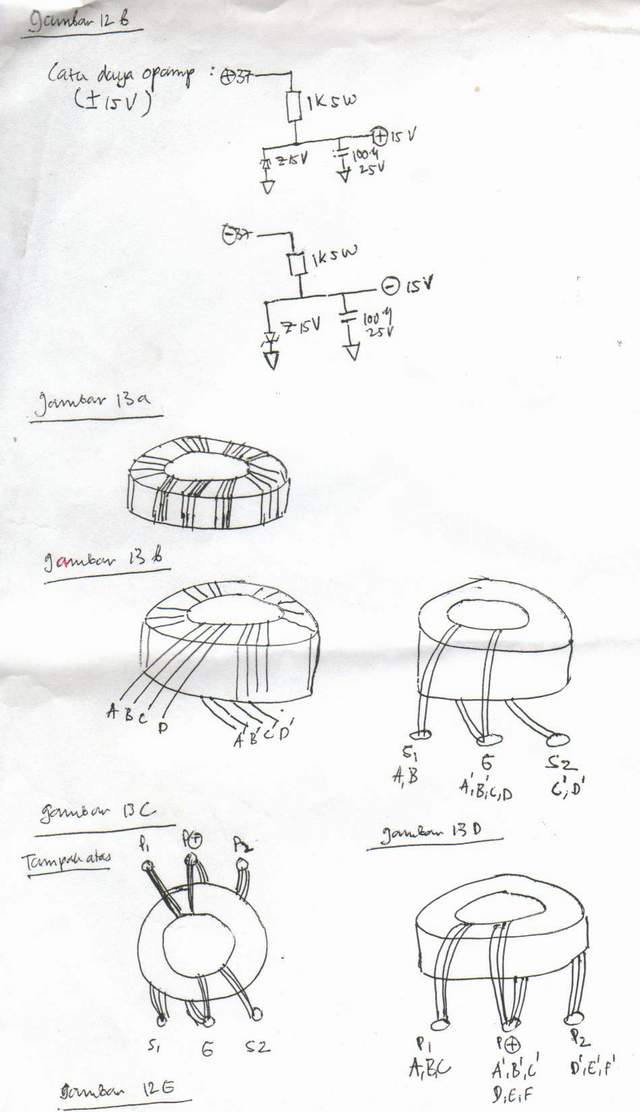
This article is intended for individuals interested in constructing their own car amplifier. The fundamental calculations involved will be discussed below. Understanding these concepts will enable the construction of a car amplifier independently. The complexity of designing a car power amplifier primarily lies not in the audio power amplifier itself, but in providing the necessary switching power supply. The peak-to-peak supply voltage (Vpp) and speaker impedance load (Rl) are critical parameters. For a car voltage of 12V DC connected to 4 Ohm speakers, the power output is limited to 144/32 = 4.5 Watts. Bridging the amplifier can double the power, but it will not exceed 40 Watts. To achieve a more powerful amplifier, such as 170 Watts at a 4 Ohm speaker load, a supply voltage of 74Vpp or ±37V DC is required. This voltage can be obtained from a 12V DC car supply by using a DC-DC converter. The first stage of the amplifier receives the input audio signal and a negative feedback (NFB) signal from the amplifier's output. This feedback is essential for stabilizing the audio amplifier, similar to the gain factor. The first stage, constructed with discrete transistors, feeds both signals to the base of the transistor, functioning like the non-inverting and inverting inputs of an operational amplifier. The input signal, typically from a car radio or CD player, has a low voltage of approximately 1Vpp with a few milliamperes of current. To produce 170 Watts at a 4 Ohm speaker load, the signal must have a magnitude of 28Vpp and a current of 6.5A (derived from the equation P=I²*R = V²/R). The first stage receives this signal at the non-inverting input, while the inverting input receives the NFB signal to maintain a consistent voltage gain, for example, 28 times. However, the output signal from the first stage does not reach 28Vpp; it tends to have a magnitude similar to the input voltage. The second stage amplifies the voltage generated by the first stage. This stage increases the voltage to produce a signal that is 28 times larger, resulting in a 28Vpp signal from a 1Vpp input signal. However, this 28Vpp signal still has a low current, only a few milliamperes, and is insufficient to drive the speaker load. The third stage amplifies the current from a few milliamperes to 6.5A. The explanations for the three stages above are more complex in actual amplifier designs. The principle of transistor gain, represented as G=RC/RE, must be applied to each transistor in these three amplifier stages. The first stage design features a Constant Current Source (CCS), which is crucial for maintaining consistent performance. According to electronic law, the voltage drop between the base and emitter (Vbe) equals the voltage drop across one diode, approximately 0.67V. Therefore, if two diodes (e.g., IN4148) are used, the total voltage drop is 2 x 0.67V = 1.34V. In this configuration, the voltage drop across RE and Q1 indicates that V=0.67 is subtracted by Vbe of Q1, leaving the remaining 0.67V as the drop across RE. Consequently, the CCS provides a current of 0.67/RE. The CCS in the first stage typically varies between 1-4mA. Before discussing the second and third stages, it is necessary to examine the amplifying effect of a transistor. The Common Emitter Mode (CEM) circuit amplifies voltage, while the Common Collector Mode (CCM) circuit amplifies current without amplifying voltage. Therefore, to amplify voltage, the CEM circuit is utilized, while the CCM circuit is employed for current amplification. The second stage is responsible for the total voltage gain (maximum voltage swing) in an audio power amplifier, which is why it is commonly referred to as the Voltage Amplifier Stage (VAS). This stage consists of a voltage amplifier (CEM transistor) at the bottom, a Constant Current Source at the top, and a bias control circuit in the middle. The CCS in the second stage has a current magnitude between 4-8mA. An important capacitor in the second stage, known as the Miller Capacitor (CC), defines the pole of the frequency response for the audio amplifier and is typically of small magnitude (a few picofarads). The bias control circuit comprises a transistor, resistor, and variable resistor (VR), and is usually placed on a heatsink to ensure efficient heat compensation for bipolar transistors. For amplifiers utilizing MOSFET transistors, the bias circuit only requires a potentiometer or diode due to the different thermal characteristics of MOSFETs compared to bipolar transistors. The bias voltage magnitude depends on the type of third stage used, which will be discussed later. The third stage, or output stage, serves as the current amplifier. The third stage and bias circuit determine whether the amplifier operates in class A, class AB, or class B. It is noted that nearly 90% of car audio power amplifiers operate in class B. Class B operation does not imply poor sound quality; with proper design, both class A and class B amplifiers can yield excellent audio results. The choice of class B for car audio power amplifiers is related to efficiency and heat generation. Heat management is critical, as neglecting this factor can lead to amplifier failure. Various output stage configurations exist, each with different optimal bias voltages depending on the number of Vbe drops required. For example, if the signal passes through four Vbe drops, the optimum bias voltage would be 4 x 0.67V = 2.68V. When connecting the three stages discussed above, a complete circuit is formed. Key components of this circuit include the determination of the negative feedback (NFB) resistor value, which is calculated using the gain factor equation: Gain = 1+(R10/R8) = 1+10k/500 = 21x. The value of R10 is equal to R1 for input balancing. R20 and C7 serve as the pole and slope compensators, while R21, R22, and C11 stabilize the CCS. The CCS employs a two-transistor system, with the equation Ic = 0.67/RE still applicable. The output from the differential pair is tapped from the collector of T10 and sent to the VAS, which consists of T12 and T4. This configuration is known as Darlington VAS, and the value of R8 is standard. R18, C6, L1, and R19 stabilize the output power. If any oscillations occur in the audio power amplifier, R18 is typically the first component affected, along with the final transistors. Car power amplifiers are usually connected to low impedance speakers, typically 4 ohms, which can drop to ½ ohm in bridge mode, leading to the term "High Current Amplifier." The distinction lies in the number of final transistors, represented by pairs of T7 and T8 in the circuit. A rule of thumb is that the current handling capacity of transistors must be calculated based on the equations provided, with the assumption that one transistor can manage 50 Watts output. A pair of bipolar transistors can handle 100 Watts. The power can be increased by paralleling several output transistors, allowing for greater current flow. For large numbers of output transistors, the pre-driver stage may be modified to a Darlington configuration. Several designs employ symmetrical configurations, similar to those found in AXL and Crescendo schematics. These designs evolve from the fundamental principles outlined above, with the signal handling for the positive and negative parts managed by complementary circuits. An example of a different type of power amplifier, a non-feedback amplifier, is represented by the "Millennium Power Amplifier." The principles of this amplifier involve specific gain factors in the first and second stages, while the third stage functions solely as a current amplifier. To construct a car power amplifier, a symmetrical power supply (+, 0, -) is necessary, achievable through a DC-DC converter. The discussed converter system will utilize a Switch Mode Power Supply (SMPS) type PWM (Pulse Width Modulation), which provides a stable output voltage regardless of the input voltage (typically ranging from 9-15V DC in car electrical systems). To elucidate the SMPS type PWM, it can be analogized with a voltage pulse V1 that is on-off with a 50% duty cycle. When passed through suitable inductors and capacitors, these pulses transform into a steady voltage V2, where V2 = ½ V1. By adjusting the pulse width of V1, the output voltage V2 can be increased or decreased accordingly. For instance, to obtain 30V DC from a 12V DC source, V1 can be set to 60V DC, yielding 30V DC at a 50% duty cycle. This process is controlled by a power switching transformer, which converts 12V DC to 60V DC and is subsequently modulated by PWM. This principle aligns with class D digital power amplifier designs. In this application, regulating PWM integrated circuits (ICs), such as TL494, TL594, SG3524, and SG3525, are utilized. These ICs compare the output of the DC-DC converter with a reference voltage. If the output is lower than the reference voltage, the IC increases the pulse width to raise the voltage; conversely, if the output exceeds the reference voltage, the IC reduces the pulse width to decrease the output voltage. Generally, SMPS used in car audio amplifiers operate in a push-pull configuration with switching frequencies ranging from 20-70kHz. In the push-pull system, transistors Q1 and Q2 alternate the switched current pulses, ensuring maximum flux swing change in the transformer without saturating the core. This design will be implemented with the SG3524 PWM IC from SGS Thompson, with specifications available on the SGS Thompson website. The configuration of the 16 pins on this IC facilitates various functions essential for the operation of the SMPS.
1. The Remote Turn On circuit, connected to the car radio or CD player, activates the SMPS by supplying 12V DC to pins 12, 13, and 15.
2. The SMPS switching frequency is set to 50kHz, determined by the internal clock of the SG3524 IC, which is adjusted to 100kHz using components connected to pins 7 (Ct) and 6 (Rt). The frequency can be calculated with the equation Fclk = 1/(Rt x Ct), using Ct = 1nF and Rt = 10kΩ.
3. Pin 1 (Inv In) is designated as the output voltage detector for the 12V DC line.This article is for those who wants to make their own car amplifier. The basics of calculation will be discussed below. If you have understand it you will be able to make car amplifier yourself. Actually the difficulty of designing the car power amplifier does not lies with the audio power amplifier, but it is more to providing the switching power supply. where Vpp= peak to peak supply voltage, Rl is the speaker impedance load. For car voltage of 12Vdc, if we connect it to 4 Ohm speakers we will only have power of 144/32 = 4, 5 Watt. Bridging the amplifier will double the power, but will never be more than 40 W. If we want to make more powerful amplifier, lets say 170 watt at 4 ohm speaker load, we will need supply voltage of 74Vpp, or +/- 37 Vdc.
The way to have this voltage from car supply of 12VDC is to make DC-DC converter. First stage is the stage that receives the input audio signal and Negative Feedback (NFB) signal from the output of the amp. Feedback is the back signal used to stabilized the audio amplifier, like the gain factor. For first stage built by discrete transistors, both signals is fed to basis of the transistor, like in fig1.
Both basis of the transistors is the Non- Inverting input and Inverting Input, like those in the op-amp. We can explain those stages in a simple way like this : Input signal, like from car radio or CD player have low voltage, about 1Vpp with few milliampere current.
To produce power of 170 Watt at 4 ohm speaker load, than the signal has to have maginitude of 28Vpp and current of 6. 5A (from the equation of P=I2*R = V2/R) The first stage receives this signal in the non-inverting input and the inverting input receives NFB signal to make sure the voltage gain that the amplifier produces has a constant number, lets say 28 x.
The output signal from the first stage has not reach 28Vpp, it tends to have the magnitude similiar to the input voltage. Second stage amplifies the voltage that the first stage generates. Second stage will amplifies the voltage to produce a signal that is enlarge 28x for the amplifier to have a 28Vpp signal from 1Vpp signal, but this 28Vpp signal still have small current, only a few mA and cannot drive the speaker load.
The third stage amplifies the current from few mA to 6. 5 A. Offcourse the explenation for three stages above is not that simple in the real amplifier. We should take the nature`s law for a transistor gain, that is G=RC/RE. This principles must be applied in each transistor in those 3 amplifier stages. First stage designs have main component, that is Constant Current Source (CCS) which can be seen in fig2. One of the basic of electronic law that works on every circuit is that the voltage drop of Basis and Emitor (Vbe) equals the drop voltage of one dioda = 0.
67V. It can be seen in fig2 that the voltage drop of 2 dioda IN4148 = 2 x 0. 67V = 1, 34V. We can see in RE and Q1, then V=0, 67 is substracted by Vbe of Q1 and the other 0, 67V will be the drop of RE. So we will have a Constant Current Source of 0, 67/RE. In fig2 the Ic is = 4, 4mA. CCS first stage varies between 1-4mA. Before we discuss Second Stage and Third stage, first we will discuss the amplifying effect of a transistor.
In fig3a we will see a circuit of Common Emitor Mode (CEM). This circuit will amplifies the voltage. In fig3b we see a Common Colector Mode (CCM). This circuit is the current amplifier without voltage amplifier. So if we want to amplifies voltage we use CEM circuit and to amplifies current we use CCM circuit. The Second stage responsibles for all voltage gain (Maximum Voltage Swing) in an audio power amplifier. This is why the Second stage is generally known as VAS or Voltage Amplifier Stage. This stage consist of a voltage amplifier/CEM transistor(Q5 in fig1 ) in the bottom, Constant Current Source in the top, and a bias control circuit in the middle.
Second stage CCS has current magnitude between 4-8mA In the second stage there is an important capacitor for an audio power amplifier, that is Miller Capacitor (CC in fig1 ). CC defines the pole of the frequency response for an audio amplifier and the magnitude usually in small order (severalpF).
Bias control circuit consist of a transistor, resistor and a VR like in fig5. This circuit uses a transistor that is placed in the heatsink, because the transistor have good heat compensation factor (for bipolar transistors). For the amplifier that uses mosfet transistor for the final device, the bias circuit only needs potentio or dioda only because mosfets have different heat characteristic than bipolar transistors.
The bias voltage magnitude depends on the type of the third stage used, which will be discussed later. Third stage / Output Stage is the current amplifier. Third stage and the bias circuit will defines whether an amplifier works in class A, class AB or class B.
It can be said that almost 90 % of car audio power amplifier works in class B. Operation in class B does not mean that the sound produced is not good or corrupted. With good design, we will have good audio results, both from class A or class B. The choice of class B in car audio power amplifier is conected to efficiency and the heat generated. Heat generated is a very important factor, because if not considered carefully, it will lead to amplifier breakdown. Many configurations of the output stage can be seen in fig4. Each configuration has different optimum bias voltage. It depends on how many Vbe`s that have to be passed. Example : In fig4(a) the signal has to pass 4 Vbe`s, which is Vbe Q1, Q3, Q4 and Q2. So the optimum bias = 4 x 0. 67V = 2. 8V. Both 3 stages that we have discussed above, if we connect the together will be a circuit that can be seen in fig5.
Parts of this circuit can be explained like this: - The value of Negative Feedback (NFB) resistor is determined by determining the gain factor with the equation : Gain = 1+(R10/R8) = 1+10k/500 = 21 x. The value of R10 = value of R1 to balance input. R20 and C7 are the pole and slope compensator. - R21, R22 and C11 will stabilize CCS. Here we use CCS with 2 transistor system, but the equation used still the same, that is Ic = 0, 67/RE.
- The output of differential pair tapped from collector of T10 and send to VAS which is built by T12 and T4. This configuration is called Darlington VAS and the value of R8 is standard. - R18, C6, L1 and R19 are output power stabilisator. If there is any oscilation occur in the audio power amplifier, the first tobe effected is R18 besides the final transistors.
Car Power amplifier usually loaded by low impedance speakers, usually 4 ohms and can reach ½ ohm on bridge mode. Here we know the term High Current Amplifier . The difference is the number of final transistors, or in fig5 it is the number of pairs of T7 and T8.
As a rule of thumb, the number of transistor needed first has tobe calculated by equations above, and then we determine the number of final transistor needed with assumption that 1 transistor can handle 50 Watt output. A pair of bipolar transistor can handle 100 Watt. The power is raised by parrarelling several output transistors, so the currrent flowing will be larger.
For large number of final transistors, we change the predriver stage with darlington configuration. Several designs uses symetrical design, like those used in AXL and Crescendo schematic. this design is developed from the basic principal above, but the signal handling for + and - part is handled by complementary circuits. I have an example about another kind of power amplifier, that is a non-feedback amplifier. You can view the principles of the "millenium power amplifier" in the. This amplifier has a certain gain factor in first and second stage, while the third stage is only current amplifier.
For building car power amplifier, we need symmetrical power supply (+, 0, -) by building DC-DC converter. The converter system discussed below will be the SMPS(Switch Mode Power Supply) type PWM (Pulse Width Modulation).
This system will deliver stable output voltage, regardless of the input voltage (usually the car electrical system will range in 9-15Vdc). To explain the SMPS type PWM, it can be analogued by the next example. Look at fig6. There is a voltage pulse V1 on-off with 50% wide. These pulses if passed through suitable L and C filter will be transformated into straight voltage of V2 which is V2 = ½ V1.
(noticed the marked area below pulsed V1 is the same total area of the marked straight V2 ). With the same logic, if the pulse width of V1 is narrowed, we will have a lower V2 and if we enlarge the width of V1 pulse, we will have higher V2. Some may ask, how can we get 30VDC from the car`s 12VDC The answer is simple. If we get the V1 voltage to 60VDC, then in the 50% duty cycle, we will get 30VDC straight. This is the part where the power switching transformer takes control, to make the 60VDC from 12VDC, and then chopped by the PWM.
This is the princip of PWM. (Like the principal of class D digital power amplifier). In this design, we use regulating PWM IC`s, like TL494, TL594, SG3524, SG3525. These IC`s will compare the output of DC-DC converter with a reference voltage. If the output of DC-DC converter is smaller than reference voltage, then the IC will enlarge the pulse width so the voltage will raise equally to to reach determined voltage. So as if the output of DC-DC converter is higher than the reference voltage, the IC will narrow the pulse width so the output voltage will be lowered to the determined voltage.
Generally SMPS used in car audio amplifier is the push-pull system with switching frequency between 20-70Khz. In push pull sytem like in fig7, Q1 and Q2 gives alternating switched current pulses so the transformator will be objected to maximum flux swing change without saturating the core.
In this design we will use PWM IC with SG3524 from SGS Thompson. Specifications can be seen in SGS Thompson`s website. Fig8 shows the configuration of 16 pins on this IC. To make is simpler, lets design a SMPS by explaining the function of each pin. 1. First we make the Remote Turn On circuit, which is connected from the car radio / CD player. The circuit can be seen in fig9a. This circuit will turn on the SMPS by giving 12Vdc to pin 12, pin 13 and pin 15. 2. The SMPS switching frequency is determined 50Khz. For this, the clock inside IC SG3524 is adjusted 2 x 50 Khz = 100Khz. This clock is built up by pin 7(Ct) and pin 6(Rt). The approach can be done with equation Fclk = 1 /(Rt x Ct). Here we use Ct = 1nF and Rt = 10Kohm like in fig9b 4. Pin 1(Inv In) is the output voltage detector. of 12VDC line. 🔗 External reference
1. The Remote Turn On circuit, connected to the car radio or CD player, activates the SMPS by supplying 12V DC to pins 12, 13, and 15.
2. The SMPS switching frequency is set to 50kHz, determined by the internal clock of the SG3524 IC, which is adjusted to 100kHz using components connected to pins 7 (Ct) and 6 (Rt). The frequency can be calculated with the equation Fclk = 1/(Rt x Ct), using Ct = 1nF and Rt = 10kΩ.
3. Pin 1 (Inv In) is designated as the output voltage detector for the 12V DC line.This article is for those who wants to make their own car amplifier. The basics of calculation will be discussed below. If you have understand it you will be able to make car amplifier yourself. Actually the difficulty of designing the car power amplifier does not lies with the audio power amplifier, but it is more to providing the switching power supply. where Vpp= peak to peak supply voltage, Rl is the speaker impedance load. For car voltage of 12Vdc, if we connect it to 4 Ohm speakers we will only have power of 144/32 = 4, 5 Watt. Bridging the amplifier will double the power, but will never be more than 40 W. If we want to make more powerful amplifier, lets say 170 watt at 4 ohm speaker load, we will need supply voltage of 74Vpp, or +/- 37 Vdc.
The way to have this voltage from car supply of 12VDC is to make DC-DC converter. First stage is the stage that receives the input audio signal and Negative Feedback (NFB) signal from the output of the amp. Feedback is the back signal used to stabilized the audio amplifier, like the gain factor. For first stage built by discrete transistors, both signals is fed to basis of the transistor, like in fig1.
Both basis of the transistors is the Non- Inverting input and Inverting Input, like those in the op-amp. We can explain those stages in a simple way like this : Input signal, like from car radio or CD player have low voltage, about 1Vpp with few milliampere current.
To produce power of 170 Watt at 4 ohm speaker load, than the signal has to have maginitude of 28Vpp and current of 6. 5A (from the equation of P=I2*R = V2/R) The first stage receives this signal in the non-inverting input and the inverting input receives NFB signal to make sure the voltage gain that the amplifier produces has a constant number, lets say 28 x.
The output signal from the first stage has not reach 28Vpp, it tends to have the magnitude similiar to the input voltage. Second stage amplifies the voltage that the first stage generates. Second stage will amplifies the voltage to produce a signal that is enlarge 28x for the amplifier to have a 28Vpp signal from 1Vpp signal, but this 28Vpp signal still have small current, only a few mA and cannot drive the speaker load.
The third stage amplifies the current from few mA to 6. 5 A. Offcourse the explenation for three stages above is not that simple in the real amplifier. We should take the nature`s law for a transistor gain, that is G=RC/RE. This principles must be applied in each transistor in those 3 amplifier stages. First stage designs have main component, that is Constant Current Source (CCS) which can be seen in fig2. One of the basic of electronic law that works on every circuit is that the voltage drop of Basis and Emitor (Vbe) equals the drop voltage of one dioda = 0.
67V. It can be seen in fig2 that the voltage drop of 2 dioda IN4148 = 2 x 0. 67V = 1, 34V. We can see in RE and Q1, then V=0, 67 is substracted by Vbe of Q1 and the other 0, 67V will be the drop of RE. So we will have a Constant Current Source of 0, 67/RE. In fig2 the Ic is = 4, 4mA. CCS first stage varies between 1-4mA. Before we discuss Second Stage and Third stage, first we will discuss the amplifying effect of a transistor.
In fig3a we will see a circuit of Common Emitor Mode (CEM). This circuit will amplifies the voltage. In fig3b we see a Common Colector Mode (CCM). This circuit is the current amplifier without voltage amplifier. So if we want to amplifies voltage we use CEM circuit and to amplifies current we use CCM circuit. The Second stage responsibles for all voltage gain (Maximum Voltage Swing) in an audio power amplifier. This is why the Second stage is generally known as VAS or Voltage Amplifier Stage. This stage consist of a voltage amplifier/CEM transistor(Q5 in fig1 ) in the bottom, Constant Current Source in the top, and a bias control circuit in the middle.
Second stage CCS has current magnitude between 4-8mA In the second stage there is an important capacitor for an audio power amplifier, that is Miller Capacitor (CC in fig1 ). CC defines the pole of the frequency response for an audio amplifier and the magnitude usually in small order (severalpF).
Bias control circuit consist of a transistor, resistor and a VR like in fig5. This circuit uses a transistor that is placed in the heatsink, because the transistor have good heat compensation factor (for bipolar transistors). For the amplifier that uses mosfet transistor for the final device, the bias circuit only needs potentio or dioda only because mosfets have different heat characteristic than bipolar transistors.
The bias voltage magnitude depends on the type of the third stage used, which will be discussed later. Third stage / Output Stage is the current amplifier. Third stage and the bias circuit will defines whether an amplifier works in class A, class AB or class B.
It can be said that almost 90 % of car audio power amplifier works in class B. Operation in class B does not mean that the sound produced is not good or corrupted. With good design, we will have good audio results, both from class A or class B. The choice of class B in car audio power amplifier is conected to efficiency and the heat generated. Heat generated is a very important factor, because if not considered carefully, it will lead to amplifier breakdown. Many configurations of the output stage can be seen in fig4. Each configuration has different optimum bias voltage. It depends on how many Vbe`s that have to be passed. Example : In fig4(a) the signal has to pass 4 Vbe`s, which is Vbe Q1, Q3, Q4 and Q2. So the optimum bias = 4 x 0. 67V = 2. 8V. Both 3 stages that we have discussed above, if we connect the together will be a circuit that can be seen in fig5.
Parts of this circuit can be explained like this: - The value of Negative Feedback (NFB) resistor is determined by determining the gain factor with the equation : Gain = 1+(R10/R8) = 1+10k/500 = 21 x. The value of R10 = value of R1 to balance input. R20 and C7 are the pole and slope compensator. - R21, R22 and C11 will stabilize CCS. Here we use CCS with 2 transistor system, but the equation used still the same, that is Ic = 0, 67/RE.
- The output of differential pair tapped from collector of T10 and send to VAS which is built by T12 and T4. This configuration is called Darlington VAS and the value of R8 is standard. - R18, C6, L1 and R19 are output power stabilisator. If there is any oscilation occur in the audio power amplifier, the first tobe effected is R18 besides the final transistors.
Car Power amplifier usually loaded by low impedance speakers, usually 4 ohms and can reach ½ ohm on bridge mode. Here we know the term High Current Amplifier . The difference is the number of final transistors, or in fig5 it is the number of pairs of T7 and T8.
As a rule of thumb, the number of transistor needed first has tobe calculated by equations above, and then we determine the number of final transistor needed with assumption that 1 transistor can handle 50 Watt output. A pair of bipolar transistor can handle 100 Watt. The power is raised by parrarelling several output transistors, so the currrent flowing will be larger.
For large number of final transistors, we change the predriver stage with darlington configuration. Several designs uses symetrical design, like those used in AXL and Crescendo schematic. this design is developed from the basic principal above, but the signal handling for + and - part is handled by complementary circuits. I have an example about another kind of power amplifier, that is a non-feedback amplifier. You can view the principles of the "millenium power amplifier" in the. This amplifier has a certain gain factor in first and second stage, while the third stage is only current amplifier.
For building car power amplifier, we need symmetrical power supply (+, 0, -) by building DC-DC converter. The converter system discussed below will be the SMPS(Switch Mode Power Supply) type PWM (Pulse Width Modulation).
This system will deliver stable output voltage, regardless of the input voltage (usually the car electrical system will range in 9-15Vdc). To explain the SMPS type PWM, it can be analogued by the next example. Look at fig6. There is a voltage pulse V1 on-off with 50% wide. These pulses if passed through suitable L and C filter will be transformated into straight voltage of V2 which is V2 = ½ V1.
(noticed the marked area below pulsed V1 is the same total area of the marked straight V2 ). With the same logic, if the pulse width of V1 is narrowed, we will have a lower V2 and if we enlarge the width of V1 pulse, we will have higher V2. Some may ask, how can we get 30VDC from the car`s 12VDC The answer is simple. If we get the V1 voltage to 60VDC, then in the 50% duty cycle, we will get 30VDC straight. This is the part where the power switching transformer takes control, to make the 60VDC from 12VDC, and then chopped by the PWM.
This is the princip of PWM. (Like the principal of class D digital power amplifier). In this design, we use regulating PWM IC`s, like TL494, TL594, SG3524, SG3525. These IC`s will compare the output of DC-DC converter with a reference voltage. If the output of DC-DC converter is smaller than reference voltage, then the IC will enlarge the pulse width so the voltage will raise equally to to reach determined voltage. So as if the output of DC-DC converter is higher than the reference voltage, the IC will narrow the pulse width so the output voltage will be lowered to the determined voltage.
Generally SMPS used in car audio amplifier is the push-pull system with switching frequency between 20-70Khz. In push pull sytem like in fig7, Q1 and Q2 gives alternating switched current pulses so the transformator will be objected to maximum flux swing change without saturating the core.
In this design we will use PWM IC with SG3524 from SGS Thompson. Specifications can be seen in SGS Thompson`s website. Fig8 shows the configuration of 16 pins on this IC. To make is simpler, lets design a SMPS by explaining the function of each pin. 1. First we make the Remote Turn On circuit, which is connected from the car radio / CD player. The circuit can be seen in fig9a. This circuit will turn on the SMPS by giving 12Vdc to pin 12, pin 13 and pin 15. 2. The SMPS switching frequency is determined 50Khz. For this, the clock inside IC SG3524 is adjusted 2 x 50 Khz = 100Khz. This clock is built up by pin 7(Ct) and pin 6(Rt). The approach can be done with equation Fclk = 1 /(Rt x Ct). Here we use Ct = 1nF and Rt = 10Kohm like in fig9b 4. Pin 1(Inv In) is the output voltage detector. of 12VDC line. 🔗 External reference
